| Listing 1 - 7 of 7 |
Sort by
|
Book
ISBN: 2257152794 9782257152794 Year: 2004 Publisher: Paris: Flammarion Médecine-Sciences,
Abstract | Keywords | Export | Availability | Bookmark
 Loading...
Loading...Choose an application
- Reference Manager
- EndNote
- RefWorks (Direct export to RefWorks)
Air Pollutants --- Disorders of Environmental Origin --- Respiratory Tract Diseases --- Hypersensitivity --- Luchtverontreiniging --- Stofvervuiling --- Pollen --- Afval --- Milieuhygiëne --- Allergieën --- Mycologie --- Pulmonologie --- Beroepsziekten --- Pollution de l'air --- Poussière (Pollution par la) --- Pollens --- Déchets --- Hygiène de l'environnement --- Allergies --- Pneumologie --- Maladies professionnelles
Periodical
ISSN: 17438977 Year: 2004 Publisher: London : BioMed Central,
Abstract | Keywords | Export | Availability | Bookmark
 Loading...
Loading...Choose an application
- Reference Manager
- EndNote
- RefWorks (Direct export to RefWorks)
Particles --- Fibers --- Particules (Matière) --- Fibres --- Toxicology --- Periodicals. --- Periodicals --- Toxicologie --- Périodiques --- Air Pollutants --- Dust --- Mineral Fibers --- toxicity. --- adverse effects. --- Toxicology. --- Housedust --- House Dust --- Dust, House --- Size of particles --- toxicology --- materials science --- biomaterials --- nanomedicine --- Allergens --- Pyroglyphidae --- Materials --- Clay --- Colloids --- Sand --- Soils --- adverse effects --- Hygiene. Public health. Protection --- Grammar, Comparative and general Particles --- Grammar, Comparative and general --- Function words --- Ciència dels materials --- Toxicologia industrial --- Partícules (Matèria) --- Fibres. --- Ciència dels materials. --- Toxicologia industrial. --- Partícules (Matèria) --- Ciència dels materials.
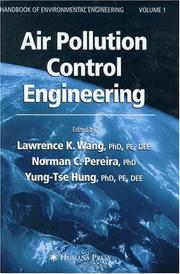
ISBN: 1588291618 1592597785 1617373974 1280360232 9786610360239 Year: 2004 Publisher: Totowa, N.J. : Humana Press,
Abstract | Keywords | Export | Availability | Bookmark
 Loading...
Loading...Choose an application
- Reference Manager
- EndNote
- RefWorks (Direct export to RefWorks)
Many human activities-and industrial production in particular-produce enormous quantities of wastes and pollution that require the development of major abatement technologies, processes whose implementation and costs must be justified by the degree of abatement achieved. In Air Pollution Control Engineering: Handbook of Environmental Engineering, Volume 1, a panel of eminent air pollution control educators and practicing professionals critically survey both the principles and practices involved in air pollution control processes. The authors discuss the performance, potential, and limitations of the major control processes-including fabric filtration, cyclones, electrostatic precipitation, wet and dry scrubbing, and condensation-as a basis for intelligent planning and realization of abatement systems. Additional chapters critically examine flare processes, thermal oxidation, catalytic oxidation, gas-phase activated carbon adsorption, and gas-phase biofiltration. The contributors also detail the Best Available Technologies (BAT) for air pollution control and provide cost data, examples, theoretical explanations, and engineering methods for the design, installation, and operation of air pollution process equipment. The emphasis throughout is on developing the necessary engineering from fundamental principles of chemistry, physics, and mathematics. A companion volume, Advanced Air and Noise Pollution Control, Handbook of Environmental Engineering, Volume 2, covers the use of multiple techniques to deal with air, thermal, and noise pollution. Cutting-edge and highly practical, Air Pollution Control Engineering: Handbook of Environmental Engineering, Volume 1 offers educators, students, and practicing engineers a strong grounding in the principles of this critical field, as well as effective methods for developing optimal abatement technologies at costs that are fully justified by the degree of abatement achieved.
Environmental protection. --- Environmental quality --- Environmental engineering. --- Environnement --- Technique de l'environnement --- Protection --- Air -- Pollution. --- Air quality management. --- Air --- Air quality management --- Civil & Environmental Engineering --- Engineering & Applied Sciences --- Environmental Engineering --- Pollution --- Luchtvervuiling : beheer --- 504.220 --- Pollution. --- Technique de l'environnement. --- Protection. --- Air contaminants --- Air pollutants --- Air pollution --- Air pollution control --- Air toxics --- Airborne pollutants --- Atmosphere --- Contaminants, Air --- Control of air pollution --- Pollutants, Air --- Toxics, Air --- Air quality --- Atmospheric deposition --- Environmental protection --- Control --- Management --- Environment. --- Environment, general.
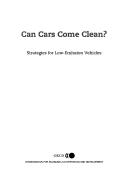
ISBN: 1280172274 9786610172276 9264104976 926410495X Year: 2004 Publisher: Paris : OECD Publishing,
Abstract | Keywords | Export | Availability | Bookmark
 Loading...
Loading...Choose an application
- Reference Manager
- EndNote
- RefWorks (Direct export to RefWorks)
This report identifies policy options and makes recommendations on market-oriented actions to promote the purchase of the most environmentally friendly vehicles. It assesses the impact of a wider use of low-emission vehicles, drawing on experience to date, research results and the responses to a survey from 18 OECD countries. The main section – Policy Options – presents in non-technical language, the current and expected performance of conventional and innovative technologies. It is for policy makers worldwide, economists and the casual reader.
Automobiles. --- Automobiles --- Air --- Mechanical Engineering --- Engineering & Applied Sciences --- Automotive Engineering --- Pollution control devices --- Motors --- Exhaust gas --- Pollution --- Air contaminants --- Air pollutants --- Air pollution --- Air pollution control --- Air toxics --- Airborne pollutants --- Atmosphere --- Contaminants, Air --- Control of air pollution --- Pollutants, Air --- Toxics, Air --- Automobile emissions --- Automobile exhaust gas --- Emissions, Automobile --- Exhaust gas, Automobile --- Emission control devices (Automobiles) --- Exhaust control devices (Automobiles) --- Pollution control devices (Automobiles) --- Smog control devices (Automobiles) --- Control --- Emissions --- Emission control devices --- Exhaust control devices --- Smog control devices --- Pollution control devices. --- Pollution control equipment
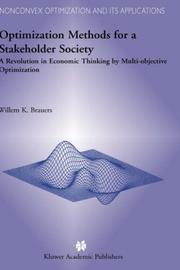
ISBN: 1402076819 1461348242 1441991786 Year: 2004 Publisher: Boston (Mass.) : Kluwer academic,
Abstract | Keywords | Export | Availability | Bookmark
 Loading...
Loading...Choose an application
- Reference Manager
- EndNote
- RefWorks (Direct export to RefWorks)
For both public and private managers, the book Optimization Methods for a Stakeholder Society is today's key to answer the problem of a sustainable development world. This world has to take into account the meaning of all stakeholders involved and has to reconcile a number of objectives, such as economic growth, employment and preservation of the ecosystem. Traditional methods, such as cost-benefit, are outmoded as they translate all these objectives into monetary costs, a materialistic approach. On the contrary, objectives have rather to stick to their own units, eventually indicators.
Numerical methods of optimisation --- Operational research. Game theory --- Economic policy and planning (general) --- Quantitative methods (economics) --- #PBIB:2004.1 --- AA / International- internationaal --- 305.976 --- Algoritmen. Optimisatie. --- Decision making --- Economic policy --- Management --- Mathematical optimization. --- Nonlinear programming. --- Mathematical models. --- Mathematical optimization --- Nonlinear programming --- Programming (Mathematics) --- Optimization (Mathematics) --- Optimization techniques --- Optimization theory --- Systems optimization --- Mathematical analysis --- Maxima and minima --- Operations research --- Simulation methods --- System analysis --- Mathematical models --- Algoritmen. Optimisatie --- Operations research. --- Decision making. --- Finance. --- Air pollution. --- Operations Research/Decision Theory. --- Finance, general. --- Atmospheric Protection/Air Quality Control/Air Pollution. --- Optimization. --- Air --- Air contaminants --- Air pollutants --- Air pollution --- Air pollution control --- Air toxics --- Airborne pollutants --- Atmosphere --- Contaminants, Air --- Control of air pollution --- Pollutants, Air --- Toxics, Air --- Pollution --- Air quality --- Atmospheric deposition --- Funding --- Funds --- Economics --- Currency question --- Deciding --- Decision (Psychology) --- Decision analysis --- Decision processes --- Making decisions --- Management decisions --- Choice (Psychology) --- Problem solving --- Operational analysis --- Operational research --- Industrial engineering --- Management science --- Research --- System theory --- Control
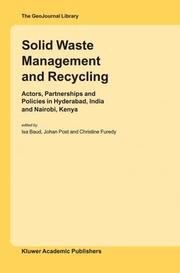
ISBN: 1280461888 9786610461882 1402025297 1402019750 Year: 2004 Publisher: Dordrecht ; Boston : Kluwer Academic Publishers,
Abstract | Keywords | Export | Availability | Bookmark
 Loading...
Loading...Choose an application
- Reference Manager
- EndNote
- RefWorks (Direct export to RefWorks)
This book is for practising professionals and academics working in urban planning and international development: international project staff, trainers, urban development researchers and teaching staff in universities and polytechnics. Solid Waste Management and Recycling is unique in that it: -utilizes an 'integrated solid waste management perspective' in its analysis; -provides embedded case study data; -deals with both formal and informal actors and institutional arrangements in solid waste management and recycling; -has chapters written by experts from the countries concerned (Kenya and India); -can be used in graduate-level courses in urban development, urban management and planning, and technical engineering courses for students, project staff, and technical students.
Environment. --- Geography. --- Environmental management. --- Air pollution. --- Atmospheric Protection/Air Quality Control/Air Pollution. --- Environmental Management. --- Geography, general. --- Cosmography --- Earth sciences --- World history --- Environmental stewardship --- Stewardship, Environmental --- Environmental sciences --- Management --- Air --- Air contaminants --- Air pollutants --- Air pollution --- Air pollution control --- Air toxics --- Airborne pollutants --- Atmosphere --- Contaminants, Air --- Control of air pollution --- Pollutants, Air --- Toxics, Air --- Pollution --- Air quality --- Atmospheric deposition --- Control --- Refuse and refuse disposal --- Recycling (Waste, etc.) --- Conversion of waste products --- Recovery of natural resources --- Recovery of waste materials --- Resource recovery --- Waste recycling --- Waste reuse --- Conservation of natural resources --- Energy conservation --- Salvage (Waste, etc.) --- Waste products --- Discarded materials --- Disposal of refuse --- Garbage --- Household waste --- Household wastes --- Rubbish --- Solid waste management --- Trash --- Waste disposal --- Waste management --- Wastes, Household --- Sanitation --- Factory and trade waste --- Pollution control industry --- Street cleaning --- Environmental aspects
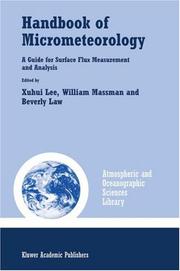
ISSN: 13838601 ISBN: 9781402022654 1402022646 9786610190478 1280190477 1402022654 9781402022647 Year: 2004 Volume: 29 Publisher: Dordrecht: Kluwer,
Abstract | Keywords | Export | Availability | Bookmark
 Loading...
Loading...Choose an application
- Reference Manager
- EndNote
- RefWorks (Direct export to RefWorks)
The Handbook of Micrometeorology is the most up-to-date reference for micrometeorological issues and methods related to the eddy covariance technique for estimating mass and energy exchange between the terrestrial biosphere and the atmosphere. It is intended to provide micrometeorologists, ecosystem scientists, boundary-layer meteorologists, and students involved in micrometeorology with the state of science on measurement and analysis. The Handbook is the culmination of many detailed discussions of theory, analysis, and practical applications by the leading scientists in the field. It provides useful advice for bringing coherence to estimates of mass and energy exchange for understanding the role of the terrestrial biosphere in global environmental change.
Air pollution. Air purification --- milieutechnologie --- meteorologie --- milieubeheer --- klimatologie --- Nature protection --- klimaatveranderingen --- Meteorology. Climatology --- luchtverontreiniging --- geologie --- Geology. Earth sciences --- Environmental protection. Environmental technology --- Physics. --- Geology. --- Environmental sciences. --- Environmental protection. --- Climatic changes. --- Atmospheric Sciences. --- Physics, general. --- Environment, general. --- Atmospheric Protection/Air Quality Control/Air Pollution. --- Climate Change. --- Changes, Climatic --- Changes in climate --- Climate change --- Climate change science --- Climate changes --- Climate variations --- Climatic change --- Climatic changes --- Climatic fluctuations --- Climatic variations --- Global climate changes --- Global climatic changes --- Climatology --- Climate change mitigation --- Teleconnections (Climatology) --- Environmental quality management --- Protection of environment --- Environmental sciences --- Applied ecology --- Environmental engineering --- Environmental policy --- Environmental quality --- Environmental science --- Science --- Geognosy --- Geoscience --- Earth sciences --- Natural history --- Natural philosophy --- Philosophy, Natural --- Physical sciences --- Dynamics --- Environmental aspects --- Atmospheric sciences. --- Environment. --- Air pollution. --- Climate change. --- Air --- Air contaminants --- Air pollutants --- Air pollution --- Air pollution control --- Air toxics --- Airborne pollutants --- Atmosphere --- Contaminants, Air --- Control of air pollution --- Pollutants, Air --- Toxics, Air --- Pollution --- Air quality --- Atmospheric deposition --- Atmospheric sciences --- Control --- Global environmental change --- Balance of nature --- Biology --- Bionomics --- Ecological processes --- Ecological science --- Ecological sciences --- Environment --- Environmental biology --- Oecology --- Population biology --- Ecology --- Micrometeorology. --- Meteorology.
| Listing 1 - 7 of 7 |
Sort by
|

 Search
Search Feedback
Feedback About UniCat
About UniCat  Help
Help News
News